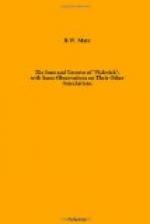“He’s a queer customer, the vun-eyed vun, sir,” observed Mr. Weller, as he led the way. “He’s a-gammonin’ that ’ere landlord, he is, sir, till he don’t rightly know vether he’s standing on the soles of his boots or on the crown of his hat.”
This was no other than the man who told the story of Tom Smart at the “Peacock,” Eatanswill, and he was ready and willing to tell another; with little persuasion he settled down and related the story of the Bagman’s Uncle.
The “Bush” was, in its time, the chief coaching inn of the city, and one of the headquarters of Moses Pickwick’s coaching business. It stood until 1864, near the Guildhall, and its site is now occupied by Lloyd’s Bank. This was another inn that Dickens stayed at in 1835 whilst reporting for The Morning Chronicle. Writing from that address he says he expects to forward the conclusion of Russell’s dinner “by Cooper’s company coach, leaving the ‘Bush’ at half-past six next morning; and by the first Bell’s coach on Thursday he will forward the report of the Bath dinner, endorsing the parcel for immediate delivery with extra rewards for the porter.”
CHAPTER XIV
The “Fox under the Hill,”
Other London taverns,
and the “Spaniards,” Hampstead
On his return from Bath, Mr. Pickwick was immediately arrested and conveyed to the Fleet Prison. In the course of the chapters following this event there are several inns or taverns either mentioned incidentally, or figure more or less prominently, such as the new public-house opposite the Fleet, the “Fox Under the Hill,” Sarjeants’ Inn Coffee House, the public-house, opposite the Insolvent Debtors’ Court, the Horn Coffee House in the Doctors’ Commons and the “Spaniards,” Hampstead Heath. Of these the “Fox Under the Hill,” casually referred to by Mr. Roker as the spot where Tom Martin “whopped the coach-heaver,” was situated on the Thames water-side in the Adelphi, at the bottom of Ivy Lane. The incident he related was no doubt a recollection of Dickens’s early days in the blacking factory at Hungerford Stairs, for the public-house was known to him, as the following sentence in his biography shows—“One of his favourite realities was a little public-house by the water-side called the ‘Fox Under the Hill,’ approached by an underground passage which we once missed on looking for it together”; and he had a vision which he has mentioned in Copperfield of sitting eating something on a bench outside, one fine evening, and looking at some coal-heavers dancing before the house.
The public-house, nevertheless, was there when Dickens and his biographer were seeking it, for it was not demolished until the Victoria Embankment was built many years later.
Robert Allbut states that the “Fox Under the Hill” was the tavern where Martin Chuzzlewit, junior, was accommodated when he arrived in London, and where he was visited by Mark Tapley.




